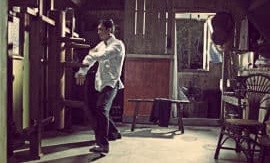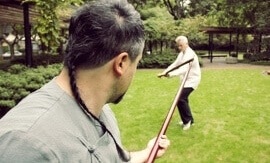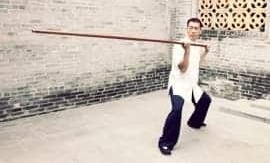
BROUGHT INTO BOXING, COMBAT SPORTS AND KALI FROM A YOUNG AGE AND EXPERIENCING THE TOUGH LIFE OF THE US MARINES CORPS, SIFU CHRIS COLLINS IS A VERSATILE AND OPEN-MINDED FIGHTER AND TEACHER WHO APPROACHED EVERYTHING HE LEARNED ON HIS JOURNEY WITH ONE PRINCIPLE IN MIND: EFFICIENCY.
What are the most important attributes to be developed through Wing Chun training?
It’s about being able to relax the muscles and allow the joints to work by way of the tendons and ligaments. This boils down to structure. If we have good structure, then we can allow our body to trust the system completely. Once you align them it becomes supportive. It’s not the same as hyper-extending the arm—it’s aligning the joints. In order to do this, we need to understand the capsule in the elbow. It’s where the ulna and radius meet the pivot joint in the elbow. If we were to tighten the fist in any way, it would cause the forearm muscles to tighten and therefore lock up the capsule “elbow”, which means we can’t release our force. Therefore, relaxation in this joint is perhaps the most important attribute in Wing Chun.
Please explain the meaning of Chi Sau and what the emphasis should be while practising it?
To develop good structure, centre of gravity, a clear idea of our centreline, and relaxed joints. Then we can focus on time and space. If I close the distance and take away your space, then I will be able to limit your time. When you can limit time and space, you can control the number of options available. If you can limit the options you can trap your opponent; you can feel your way through and create strategy and tactics within it. These modifications come from what we call Sections, which allow us to develop all aspects of our Wing Chun. Every possible variable is explored. We learn to approach it like a scientist would, not a fighter. We allow ourselves to develop a problem-solving mentality when bridging the gap. It allows us to become organic—not static and predictable.
Can you explain your understanding of the forms in the system?
Forms are a pathway into the ideas and how to develop them. Siu Lim Tau helps the mind discover the body. It teaches us structure, alignment and how to release our force while maintaining structure. It helps you find the balance in how much effort is required to complete an action and to create a wedge straight to our opponent’s centre.
Chum Kiu is about complex or combined action, which requires the practitioner to combine the lower with the upper torso. This is important for working in medium to close quarter range or expanding as our opponent departs. Once we wedge ourselves into our opponent’s centre, we then need to be able to remain there without becoming stiff and rigid.
Bil Tse is considered an advanced form, as it is more about cutting or slicing the lines and attacking the attack. There are more entry points due to having more angles and lock up in close quarters, as you will have the idea of how to clear your way by cutting. Allow your arms to fill the space and not wait for a completion of a cycle—a cycle that is taught in the beginning, by way of rhythm.
The Muk Yun Chong form teaches how to come in quickly and break your opponent’s rhythm, forcing him to lose his base and break time. It’s more difficult for the opponent to recover once this happens.
What do you believe to be the most important geometry and principles?
Geometry deals with shapes, sizes, positions of figures in relation to, and the properties of space going to and coming from. It’s like a spiral on a kaleidoscope, funnelling towards your opponent like a drill. To master Wing Chun, you must be able to locate every triangle while the action is being administered and be able to break it while you are also in action at full speed. You must be able to flow through time and space with a fluid changing structure in order to gain the advantage in combat.
The main principles are: Da Lik (打, the ability to let your force go), Je Lik (借力, giving in, soft force), She Lik (捨力, the ability to give in to your opponent’s force and respond with your own), Xie Lik (卸力, following your opponent’s force and riding it back towards him, using it, combined with your own). Without any of these principles in place, it would be impossible to operate effectively and result in a lack of purpose as designed by the system or most importantly the laws of nature.
How worried are you that Wing Chun is being gradually watered down?
This does not worry me. We have the ability to evolve. All martial arts are merely individual perspectives. A theory that was developed through a set of principles, modified through clear methodology and refined with a concise curriculum. Our ancestors aren’t any smarter than we are. As long as we are just as dedicated, then we can help these systems evolve and flourish. The principles can’t change nor can the geometry.
How important do you think it is to spar against other styles?
This is not something that everyone needs to do. When I came to Wing Chun, I was already a fighter. I didn’t need Wing Chun for that. I occasionally have my students spar with gloves and headgear to simply help those with little or no confidence in the physical realm to gain confidence. Guys that are more advanced in Chi Sau realise they are not necessarily the best fighters when it comes to two guys trying to knock the sense out of each other. Everyone becomes more humble.
Do you believe technical skills are limited or that the modern approach to Wing Chun lacks some important ingredients?
Keep it simple—it already has enough complexity! The problem with Wing Chun is Wing Chun itself. Technique over power is a lifelong quest. I think the main problem that impedes people’s progress is their egos. It’s about finding the ability to release any moment in time that causes you to be hard, stiff, and static. If you can remain relaxed, alive and in constant motion without having to hesitate your movement or action, then you are in bliss and operating in perfection. We can never be perfect, but that’s the pursuit. It’s not about trying to beat the guy in front of you; it’s about beating yourself. Find your weaknesses and correct them; find your strengths and step away from their comforts. Fighting is the easy part. There is enough in Wing Chun to get you where you want to be. Special ingredient? I could say hard work, but you need to have someone that understands its formlessness. Then everyone can become good.
Being an expert and teacher of other martial arts, what are the similarities and differences you find between them?
Sometimes, I don’t even realise I’m teaching one or another because I focus on my teachings or my own learnings on having a single methodology. I base it on Theory, Principle, Methodology and Curriculum. I find myself saying the same things when I’m teaching any system. There are so many similarities as well as differences. We only have two arms and two legs, so it can’t be that different. Everything we do is thought up by man, created by man, developed by man, so it can’t be too complicated to figure out.
When I was learning Wing Chun, in the beginning, I was mesmerised by the idea of these four basic principles of Wing Chun, and when I started Kali, I focused my understanding in sub-sets. They had a very distinct purpose and idea. The same proves true in Brazilian Jiu-Jitsu. It’s about understanding principles of movement, leverage, and physics. I teach based on the triangle in all the systems at my school. It’s easy to recognise similarities. I focus on structure in all the systems. Without structure, we have nothing. You have to have a solid structure in place to work from, otherwise, you are like spaghetti and your body can never learn to be precise in your actions because once you lose your structure nothing can align, you have no leverage—there is nothing to anchor or pivot from. My ultimate goal in the martial arts and in life is to find the correlation between it all.



















